At this time of year, we are deep into planning for our upcoming turtle season on the field boat and at the Sea Turtle Centre. But our minds are also full of thoughts of the nesting beach. We’re wondering what is happening in those many countries where Canadian sea turtles come ashore to lay their eggs. Last year around this time, a team from the CSTN was down in Trinidad on Matura Beach working with our friends from Nature Seekers. Kayla Hamelin, who is the CSTN’s coordinator of conservation and educational outreach, was one of the members of that team. She kept a record of her experiences in Trinidad that we want to share with you over the next few blog posts.
Notes from the Field (Trinidad, Part 1)
After several months of exceptionally brutal winter at home in Halifax, we stepped out of the airport in Port of Spain, the capital of Trinidad, into a completely different world. After adjusting to the intense humidity, I was struck by the landscape. Even from the arrivals door, a backdrop of dark green, rolling mountains loomed not too far away. A short drive later, we arrived at Suzan’s Guest House in Matura, our accommodations for this trip.
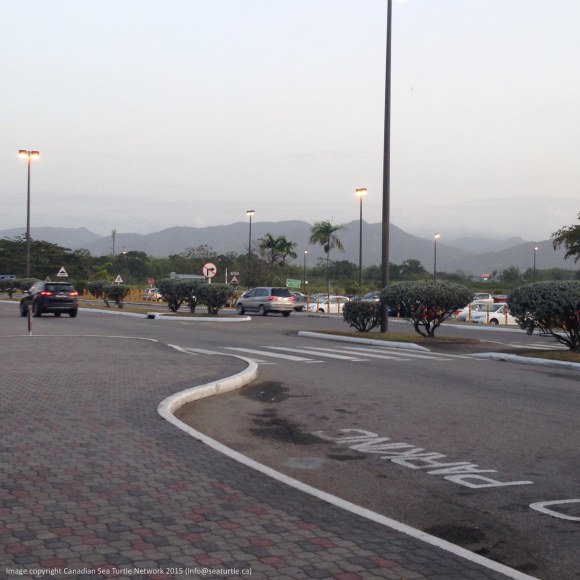
The view of the mountains from the sidewalk outside the Port of Spain airport.
This has been my first time spending time in a tropical country, and as a biologist I have been struck by the amount of life that is here in terms of both biomass and biodiversity. It is lush and green… and loud! Thick foliage surrounds us and there is a near-constant cacophony of songbirds and cicadas (not to mention the neighbour’s rooster!). I spend time watching small green lizards climb across the cement patio below, and chattering flocks of parrots fly by each evening. I can see coconut, banana, mango and lime trees from our balcony.
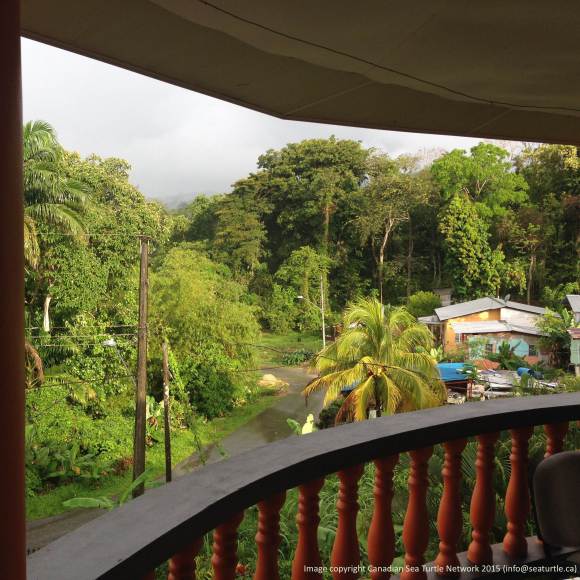
The view from the balcony at Suzan’s Guest House.
But of course the ultimate reason we are here is found a little way outside of the village of Matura at Matura Beach. This is where leatherback turtles haul themselves out of the ocean to lay their eggs. Something that makes field work on the nesting beach different from our work in Nova Scotia is that it happens at night. Typically, in Canada, when we go out on the boat to conduct our research with leatherbacks at sea, we get up very early in the morning and work throughout the day. Instead, here, our work begins after sundown. We arrived in Trinidad after an overnight flight, and although we tried to rest during the day, I was glad to have a boost of adrenaline keeping me alert as we headed out for our first night on the beach. I was really excited to see my first nesting sea turtle.
The night began with an introductory meeting with our collaborators from Nature Seekers. The Nature Seekers monitor the leatherback nesting beach and guide eco-tours to see the turtles. After deciding on a game plan for the night, we took an entertaining drive down the twisty, bumpy road to the beach. On top of having to “drive British” (in the left lane, with steering wheel on the right and gear shift on the left), we had to dodge a couple of bold local dogs and, even a loose horse that crossed our path (“I thought it was a moose!” quipped the Cape Bretoner on our Canadian research team). We finally arrived at the parking lot. Bats swooped overhead as we headed down a gravel path to the beach.
The beach itself is an amazing sensory experience; the salty smell of the sea wafts over you as incredibly rough surf pounds the beach. The humidity and the sea spray create droplets that are visible in the beam of your headlamp. Behind the sand there is thick forest, and I was particularly struck by the beauty of the arching palm trees silhouetted against the starry indigo sky. We walked for a fairly short distance when our Nature Seekers guide, Randall, said to me: “You’re going to see your first nesting leatherback tonight!” Then he pointed.
A massive turtle was just ahead of us in the sand. I would have walked right by if he hadn’t said anything! There are many large heaps of dark seaweed clumped on the beach and the animal’s black hulk blended right in. She was “body pitting,” moving her body around and digging with all four flippers, settling into the sand and selecting the best spot to start digging the nest cavity. Eventually she concentrated on digging the hole for her nest, and then began depositing her eggs. It was incredible.
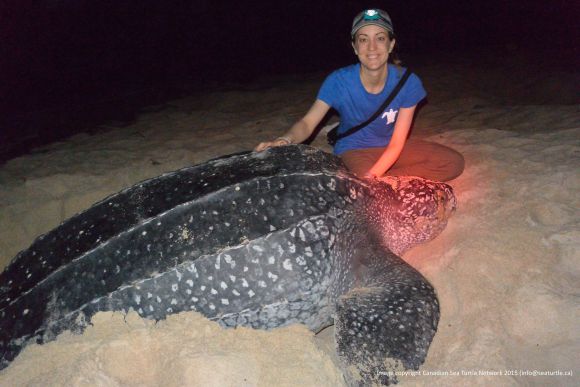
Kayla and her first nesting leatherback turtle. The light near the turtle’s head is red from the headlamps of people nearby. People use red light on the beach instead of white light because it does not disturb the turtles while they nest.
Despite two seasons at CSTN on the turtle boat working with dozens of live leatherbacks at sea, this was a completely different experience. I can only describe it as a “circle of life” moment. All of the leatherbacks we see in Nova Scotia begin their lives in a place like this. It was surprisingly emotional to see a nesting animal that had beat the odds to survive to adulthood, and had likely swam thousands of kilometres from her distant foraging grounds to be there that night. Plus, I was witnessing an incredibly ancient process. These animals have been coming up to the beach in this same way for literally millions of years.
In Nova Scotia, our at-sea field work with leatherbacks is typically hectic. To ensure their health and well-being, we have to work with the turtles very efficiently to return them to the ocean as quickly as possible. But on the nesting beach, things are much slower. It takes leatherbacks about two hours to complete the nesting process. This gives us a lot of time to take in the experience. We do most of our tagging, morphometrics, and injury assessments (“working up” the turtle) while the turtle is laying her eggs, when she enters a trance-like state.
After soaking in my first experience with a nesting turtle, we got down to business, working up this turtle, and several others that we found further along the beach. It was a successful first night.

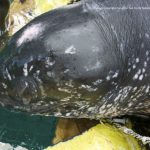
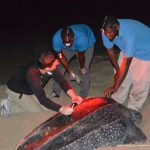
Since these turtles always return to their place of birth to lay their eggs then they must be Trinidadian turtles, not Canadian turtles. Love your website though. Keep up the good work!
Thanks!
Witnessing and being apart of the leatherback nesting process is an amazing opportunity and I think it is great that CSTN persons are getting this opportunity. But I am disturbed and concerned by the photograph of Kayla and her first nesting turtle, the statement below the image states ” People use red light on the beach instead of white light because it does not disturb the turtles while they nest.” yet a flash photograph, using white light was taken….. this disturbs the nesting turtle and is banned on many turtle nesting research programs, I realise that Trinidad allows flash photos but I find the above picture is also promoting the use of white light around nesting turtles and possibly something CSTN should consider not supporting. Can Kayla post an image where white light was not used?
I’m sorry it has taken so long to respond to your post. We had let our blog slip for a long time and are just restarting it now. Thank you for taking the time to write and express your concern. You are right. White light is banned on the nesting beach with good reason–including in Trinidad. White light can cause leatherbacks to abort their attempts to nest. It is a real conservation concern. However, research groups do allow it under specific circumstances (established on a case-by-case basis). There is a point during the nesting process when a leatherback goes into a nesting “trance” and they are not bothered by the white light. At that time, it is safe to use white light without adversely affecting the animal. These were the circumstances under which Kayla’s photograph was taken. The reason we wanted permission to take this image was so that people would be able to see the turtle’s size in relation to Kayla, as well as what the animal looked like nesting. The difficulty with red-light photographs is they are dark. Without a tripod (which we don’t carry on the beach), it isn’t possible to leave a camera shutter open long enough to allow enough light in to take a photograph that will translate easily for the general public (the camera shakes and causes a blurry image).